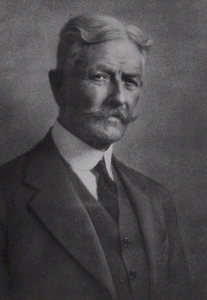KLETTING, RICHARD KARL AUGUST

Richard K.A. Kletting
Richard K.A. Kletting, "Dean of Utah Architects," helped to change the face of turn-of-the-century Salt Lake City. He was born in Wurttemberg, Germany, on 1 July 1858 to Joseph and Wilhelmina Kletting, and was one of their sixteen children. Kletting's ambition to become an architect began when he was fifteen, when he worked in a stone yard, gaining experience in cutting stones. At the age of sixteen, he became a junior draftsman in government engineering offices on railroad construction work. Kletting later traveled to Paris, where he became well-schooled in modern architecture.
In 1883 Kletting left for America, and traveled west until he arrived in Salt Lake City. On the day following his arrival, he was hired as an architect, and began work on what was to become a large number of Salt Lake City buildings. Through his work on both residential and commercial projects, Kletting became the most noted architect in Salt Lake City. In 1892, at the age of thirty-four, he began work on what was to become one of his largest and most distinct works--the original Saltair resort on the south shore of the Great Salt Lake. Completed in 1893, the resort was unlike any other building in Utah, with its intricate woodwork and Moorish appearance. The most prominent feature was the resort's vast dance floor, proclaimed as the largest in the world. Saltair became one of the Intermountain West's most popular resort attractions.
Even more striking was Kletting's last and most famous work--the Utah State Capitol building, which was completed in 1916. Kletting was chosen over forty other architects in a competition on 13 March 1912. The State Capitol building is a massive and proud structure, with classic Greek and renaissance characteristics, including a well-proportioned dome and a colonnade of twenty-four columns.
Other noteworthy Kletting buildings include many schools, including the still standing Oquirrh School, which was constructed in 1909. The McIntyre Building, located at 68 South Main Street, is also a Kletting design. Kletting also contributed to the heritage of fine homes along South Temple. The Enos Wall mansion, built in 1905, today stands as the centerpiece structure of the LDS Business College.
After completing the state capitol, Kletting entered semi-retirement, which enabled him to devote some time as a public official. He was an honorary member of the Utah Chapter of the American Institute of Architects, and the Utah Society of Professional Engineers, among other groups.
Kletting also had a strong interest in forestry. Having been dedicated to the preservation of Utah's forests, in 1891 he organized the Utah Forestry Association which helped to prevent the mismanagement of Utah's forests and mountains. His efforts were recognized in 1964 when a 12,000-foot peak in Summit Country was formally named "Kletting Peak." Kletting died in Salt Lake City on 25 September 1943.
Disclaimer: Information on this site was converted from a hard cover book published by University of Utah Press in 1994. Any errors should be directed towards the University of Utah Press.